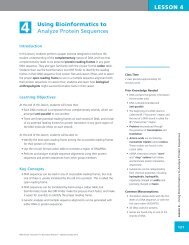WET LAB DNA Barcoding: From Samples to Sequences - Northwest ...
WET LAB DNA Barcoding: From Samples to Sequences - Northwest ...
WET LAB DNA Barcoding: From Samples to Sequences - Northwest ...
You also want an ePaper? Increase the reach of your titles
YUMPU automatically turns print PDFs into web optimized ePapers that Google loves.
<strong>WET</strong> <strong>LAB</strong><br />
Procedure<br />
Day Two<br />
7. As students enter the class, project Slide #5, “<strong>DNA</strong> Purification Overview,”<br />
<strong>to</strong> remind students of the purpose of <strong>to</strong>day’s lab. Students lysed their cells<br />
overnight and will complete the purification <strong>to</strong>day.<br />
Wet Lab: Slide #5<br />
8. When students have completed their <strong>DNA</strong> purification, collect their samples<br />
and s<strong>to</strong>re them in the refrigera<strong>to</strong>r (short term s<strong>to</strong>rage, up <strong>to</strong> 3 days) or in the<br />
freezer (long term s<strong>to</strong>rage).<br />
Lab 2: Copying the <strong>DNA</strong> <strong>Barcoding</strong> Gene<br />
Using Polymerase Chain Reaction (PCR)<br />
Using Bioinformatics: Genetic Research<br />
Teacher Preparation<br />
• Load the classroom computer with the Wet Lab PowerPoint slides.<br />
• Make copies of the Student Handout–Copying the <strong>DNA</strong> <strong>Barcoding</strong> Gene<br />
Using Polymerase Chain Reaction (PCR), one per student. These handouts<br />
are designed <strong>to</strong> be reused as a class set; students should write answers<br />
<strong>to</strong> questions and take notes on a separate sheet of paper or in their lab<br />
notebook.<br />
• Teachers may wish <strong>to</strong> have their students write out the lab procedures before<br />
the activity in their lab notebooks or on a separate piece of paper as a “prelab”exercise,<br />
which can be used as an “entry ticket” <strong>to</strong> class. During the lab,<br />
students may check off steps as they complete them and/or describe and<br />
draw pictures of their observations.<br />
• Set up student work stations by distributing supplies and reagents needed for<br />
each group, as described above under Materials. It is suggested that reagents<br />
be aliquoted for student groups and labeled as described in Student Handout<br />
–Preparation of PCR <strong>Samples</strong> for <strong>DNA</strong> Sequencing. This information is found<br />
in Teacher Resource—Aliquoting <strong>DNA</strong> <strong>Barcoding</strong> Reagents for Labs 1–4.<br />
328<br />
©<strong>Northwest</strong> Association for Biomedical Research—Updated Oc<strong>to</strong>ber 2012
















